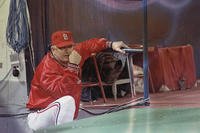 I've been fortunate over the years in that I’ve managed to remain largely neutral in the various rivalries between the different tracker training organizations here in the US. This has helped me maintain a good relationship with some very good trackers across the country (and in the UK and South Africa), which in turn has benefited me immensely as a writer, a tracker and an instructor. Today I'd like to share a lesson from one such man.
I've been fortunate over the years in that I’ve managed to remain largely neutral in the various rivalries between the different tracker training organizations here in the US. This has helped me maintain a good relationship with some very good trackers across the country (and in the UK and South Africa), which in turn has benefited me immensely as a writer, a tracker and an instructor. Today I'd like to share a lesson from one such man.
Mic Bonin is former military turned deputy sheriff. He has conducted several extraordinary follow-ups in my area (like this one) and is now a Scott-Donelan Tracking School instructor (David Scott-Donelan was one of my tracking mentors as well, along with Mike Vaught - Mic and I share the privilege of having learned from both men, though he has long since surpassed me in ability). In fact, as I write this, Mic is with the SDTS at Camp Pendleton teaching a course to some specialty MOS Marines there. This picture was taken a few hours ago:
Mic frequently posts some of the things he looks for when he tracks. Occasionally he comes up with something unorthodox that works brilliantly. For instance, he recently took photos of an area where he knew there to be tracks he couldn't see in sufficient detail to parse out and identify. He uploaded the pictures to Instagram through his phone and voilà he was able to use IG filters to pull out very detailed images. I was able to recreate that success in an entirely different terrain over the weekend in Arizona. That's certainly more high-tech than the old fashioned spoor cards we used to sketch out.
The lesson today is entitled Classic Angry Ants, and though it might seem simple there are a number of lessons to be learned.
The Classic Angry Ants Indicator
Mic Bonin, Scott-Donelan Tracking School
![]()
The classic "angry ants" indicator. This was taken during a 5 mile tactical tracking team follow-up (our quarry stepped on the ant hill in his passage). Sign like this is great because it provides us with an idea of our time/distance gap. In this particular instance, we were approximately 5 minutes behind our quarry.
As you build your tracking knowledge of your area of operations, find an ant bed in your AO and walk across it. Then time how long it takes the ants to settle back down (which will be season and species based). Needless to say it can only provide an approximation of time lapse since disturbed, but when you see something like what you see in this picture (quantity + fury), get ready for contact!
Even though this was from a training exercise, I've actually encountered this on a follow-up last year after a burglar had stepped on an ant hill during his infil. A quarter of the ants from what you see in this picture were still top side, but they were starting to calm back down. Without going into further time factor details, the spoor in the semi-active bed was upward of 30 minutes old. But let's rewind a little bit so that I can share that particular case.
The following is a generalized version of that tracking report (without the details, measurements etc) that involved the disturbed ant hill:
_________________
From my ICP (initial commencement point), I tracked the suspect's exfil route approximately 65 yards to a gravel drive that showed signs that he entered a getaway vehicle and took off (literally, indicative of the two stretches of gravel thrown back as he punched it).
I also noticed there were a bunch of recently cut trees and branches close by his exfil in a woodline. Any significance? I wasn't sure, but I took note of it. At that point the track was no longer an active track but a passive track (investigative).
I took photographs of the area of recently cut trees and branches, and then the vehicle tracks with scales. Once I was satisfied with the photos, I measured the width of the individual tire tracks, tread traction features, gaps between the tread features, and the space between the tires for axle width. I recommend that you always photograph the spoor first (whether human tracks, animal tracks, vehicle tracks, etc.) before taking your measurements. This keeps you from accidentally disturbing/contaminating the spoor evidence, or risking the perception of contamination in the case of evidence that might be used in court or develop actionable intelligence.
I returned to the scene after documenting the vehicle track evidence in order to conduct a backtrack from the burglar's entry point into the residence. The entry point was through a window on the back of the house. After completing the backtrack I came to the following conclusions regarding the suspects activity:
The suspect approached the house by way of the gravel driveway south of the residence with an average stride. The suspect walked up the driveway and stepped onto the concrete pad leading to the front door. The tracks were not visible on the sidewalk, however I located grey powder/dust on the front door welcome mat that was transferred from the driveway.
More than likely the suspect walked to the front door to knock to see if anyone was home. If someone answered, he probably would have used some sort of cover story before leaving, or worse, used forced entry. Obviously no one answered, so he put stage 2 of his plan into action. The suspect then walked back to the driveway and back out to the road but he remained on the side of the road next to the ditch.
*As a side note, the lot sizes for this neighborhood averaged approximately 2-3 acres to give you an idea of yard sizes. Most of these properties were surrounded with wooded terrain. *
Once the suspect reached the road (staying inside the ditch line), he walked along the road all the way to the woodline on the far west side of the property (approx 60 yards out). The suspect then skirted the woodline to the far north corner of the property. At one point he stepped into the shadows of the woodline, then came back out (probably due to an environmental factor like a passing car).
He then proceeded along the back edge of the property (still skirting a woodline) and up to the side of a shed behind the residence (now 30 yards from the back porch). This leg of his route is where I located the disturbed ant hill, which also provided a partial print. At this point you can probably picture he has made a "box" around the property, maintaining an escape route by the woods just a like buck would do.
He then bee-lined straight across the back yard from the shed to the back porch. He attempted to open the back door but it was locked, so he broke the window out on the left side of the door and crawled in. After stealing a safe box with important papers in it, he unlocked the front door and fled the scene to his ride.
Think about the tactics this burglar used which could be read by the spoor he left behind. Can you see how visual tracking can provide us with valuable information about our quarry and help us build our suspect profile? In addition to the evidentiary value of documentable spoor, tracking can help us get into the mind of our quarry and see things that our quarry did even without a witness being present.
In this particular case the suspect was wearing a rather small work boot, and the window that he broke was also rather small for a large adult to crawl through. When I spoke with the victims (who showed up afterwards), I asked if they had seen anyone suspicious over the last few days.
The victims said no, but they did have a worker who was cutting tree branches the entire week before for a tree cutting company on the far west woodline of their property (area of the cut trees and branches). I asked them to describe the worker and they described a short, small in stature Hispanic worker.
With that knowledge, think back on the quarry I tracked. Think about his recon tactic, going to the door first, his route by the woodline (which would have been his work area), the small work boots, the small window entry point, his vehicle parked by the area where he worked... Think this would have provided a cover story?
Track On!
M.S.B.









